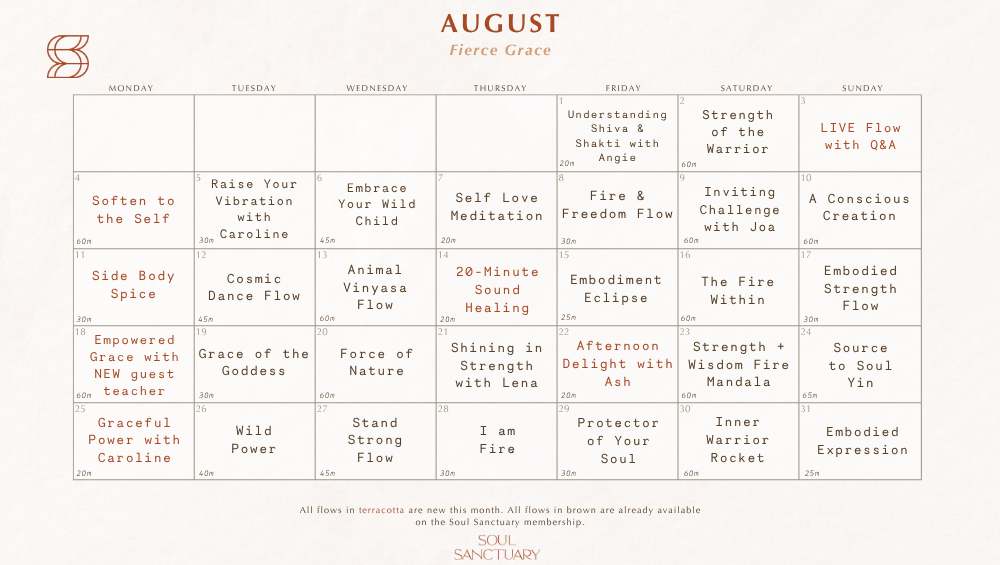
In every inhale and exhale, there is a dance between effort and ease, strength and softness, doing and being. This month, we invite you to explore Fierce Grace - a soulful exploration into the space where boldness and tenderness co-exist. To be fierce is to be rooted in truth, bold in purpose, strong in your voice - qualities often connected to the fire element and the solar plexus chakra (Manipura), our inner centre of willpower and confidence. This is the spark that drives action, helps us to set boundaries and step fully into our light.
To move with grace is to carry that fire with compassion. It’s the quiet strength that softens the edges, the courage to lead with love and the wisdom to hold power gracefully. And within each of us lives a sacred balance of masculine and feminine energy, an inner conversation that, when honoured, guides us home to ourselves.
The Fire Element In Yoga
In yogic philosophy, the fire element (Agni) is the spark of transformation. It lives in the solar plexus chakra (situated just above the navel), and governs our self-worth, inner strength, and power to act. It’s the energy that fuels change, digests experiences (both physical and emotional), and propels us forward with purpose. When fire is balanced within us, it shows up as courage, confidence, and clarity. When overwhelmed, it can burn out into anger or rigidity; when dimmed, we may feel stuck or disempowered.
Through yoga, we stoke this inner flame with practices that ask us to rise. This can be ignited through core work, standing postures, breath of fire, and dynamic flows that awaken heat and vitality. But like any flame, it needs to be tended with awareness. That’s where Fierce Grace comes in, the ability to harness your fire with love, to rise in your truth without burning out, and to walk through life both lit from within and grounded in compassion.
We must remember that an inner fire can also be ignited through slowing down, being more mindful in our practices and honouring the strength it takes to soften.


The Masculine & Feminine Within
In yogic philosophy, the sacred balance of Shiva and Shakti is central to how we understand life itself. Shiva represents pure consciousness - stable, still, and often seen as the embodiment of the divine masculine (read more about Shiva HERE). Where Shiva is stillness, Shakti is movement - creative, intuitive, and alive with the essence of the divine feminine (read more about Shakti HERE). Neither is complete without the other. Just as night turns to day and day to night, Shiva and Shakti flow in an eternal rhythm, each rising and falling as needed.
This interplay is also reflected in the subtle energies of Pingala and Ida - the masculine and feminine nadis (energy channels) that run through the body. Pingala, the solar, fiery current, carries masculine energy, action, and drive, while Ida, the lunar, cooling channel, embodies feminine qualities of receptivity, intuition, and flow. In Kundalini yoga, this dynamic balance is brought to life as energy awakens and rises through the chakras, flowing between these two channels, harmonising masculine and feminine forces within us.

We all carry both energies within us. The masculine brings action, structure, and direction, while the feminine invites fluidity, connection, and inner listening. When these forces move in harmony, they create a life that is both grounded and expressive, focused yet expansive. But when one energy takes over, an imbalance can arise. Too much masculine energy might lead to rigidity, overdoing, or disconnection from feeling. When the feminine dominates, it can feel like overwhelm, indecision, or hesitation to act.
True balance asks us to honour both and to come back to ourselves again and again. It calls for gentle pauses, honest listening, and awareness. Some days, the fire of focus will carry us, stoking the solar plexus, our seat of personal power. Other days, softness and surrender will hold space. The gift is in meeting ourselves exactly where we are, with fierce grace.

Weaving Strength & Softness on the Mat:
Your yoga practice beautifully reflects this inner balance. In yogic philosophy, masculine energy (Pingala) is active, solar, fiery - think Sun Salutations (Surya Namaskar), vinyasa flows, and dynamic arm balances. These movements warm the body, stabilise the nervous system, and honour the rising sun’s fire energy, often linked with Shiva and the solar plexus chakra.
On the other hand, feminine energy (Ida) is lunar, receptive, and nurturing and witnessed in Moon Salutations (Chandra Namaskar), yin, Hatha or restorative practices. These flows offer cooling, restorative energy, perfect for evenings or lunar phases, grounding you in fluidity and introspection.
Some days, you’ll move through a fiery Sun Salutation with your muscles engaged, breath steady, and mind sharp, tapping deeply into your masculine power and the fire of your core. But even here, the feminine is quietly present, supporting flow and presence. Other days, you’ll melt into long-held Moon Salutations or restorative yin postures, surrendering into stillness and allowing yourself to be held by the practice. And within that softness, the masculine energy remains, the gentle effort that keeps you steady and grounded.
Whether flowing through sun (fire) or moon (water), strength or surrender, both energies weave together in subtle ways, inviting balance on and off the mat. But this dance doesn’t end with movement alone. Masculine and feminine energies ripple through the entire yogic landscape, shaping breath, energy, and being.
In pranayama, for example, the active breath of fire channels masculine discipline, while soft, circular breathing leans into feminine intuition. In Kundalini yoga, Shakti energy awakens through kriyas, rising to meet Shiva at the crown. Across the chakras, the lower centres - root, sacral, solar plexus - often carry our inner fire and masculine qualities like stability and drive, while the upper centres open us to compassion, vulnerability, and wisdom. Even the Koshas, our five layers of being, reflect this balance, the physical and energetic bodies grounded in doing, while the emotional and bliss layers/sheaths invite feeling and flow. The key isn’t to favour one over the other, but to cultivate awareness of when each energy is needed. That’s what Fierce Grace truly is.

Fierce Grace in Daily Life
Off the mat, Fierce Grace is the moment you hold your ground and speak your truth, but do so with kindness. It’s the decision to take action, not from fear or force, but from clarity. It’s allowing yourself to rest without guilt, and to rise with courage when it’s time to move.
Life doesn’t always ask us to choose strength or softness; it asks us to know when to call on each. There will be phases where your masculine rises (action, ambition, growth), and times where your feminine leads (reflection, healing, release) - both are sacred and both are needed.

Fierce Grace is not a destination, it’s a practice. A way of meeting each moment with strength and softness, knowing when to stand tall and when to lean in. In your breath, on your mat, in your life, take time to honour the rhythm of Shiva and Shakti within. Let the fire of your purpose meet the grace of your presence. Remember to rise with purpose and soften with presence, and may this month be a reminder for you that you are allowed to be both powerful and tender. Fierce and full of grace.

